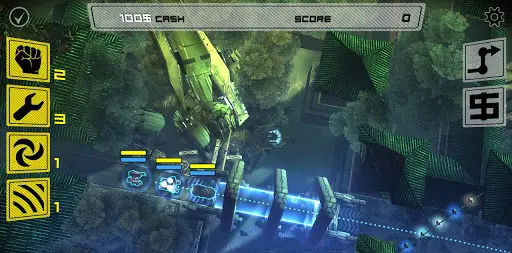At Hardcore Droid, we don’t usually cover the masses of “strategy lite” tower defense games cluttering up the market. The genre has exploded alongside the popularity of touch screen phones and while some are very good, most are pretty far from “hardcore.” But casual gaming shouldn’t be discounted. Sometimes it has things to teach us. Last year, Anomaly: Warzone Earth’s unique reversal of the tower defense genre – tower offense, if you will – coupled light strategy with an almost puzzle-like quality, and gorgeous graphics powered by the Unity engine. The result was most certainly worth a look to core gamers and casuals alike.
Anomaly Korea follows closely behind the original. At a glance, it almost seems like an expansion pack, with very similar graphics and gameplay. Each stage beings with a map of the level. Players choose a path through the city streets, and your units begin marching along the dotted line. You’re equipped with various support abilities that allow you to do things like repair your units, power them up, or protect them with a smokescreen. As you progress, you’ll get more of these power ups as well as resources you can use to purchase or upgrade units.
In its basic form, there’s not a lot of tactical depth. The result is something between tower defense and Lemmings, as you try to deploy your abilities at the right spots to get your convoy to the goal. Despite that simplicity, the original was a lot of fun, aided by its terrific presentation and gritty, realistic graphics. Korea may seem similar on the surface, but its well-designed campaign actually holds quite a few surprises.
In a single-player strategy game, level design is everything, and this is where 11-bit Studios has really stepped up its game. In Warzone Earth your goals were mostly just to pass through a series of checkpoints to reach a designated end point. In Korea the objectives are more varied, including killing all of a certain target, defending units, and collecting resources. More importantly, the way they’re designed is far less linear, and even checkpoints can be reached out of order.
Stages will also present you with unique challenges, like interior areas where you can’t buy or upgrade units, or a stage where support abilities are completely disabled, forcing you to use enemy artillery fire to bait the enemies into firing on their own towers. In the first half of Anomaly Korea I had to scratch my head and think more than I did in the entire game of Warzone Earth.
The presentation has not changed much. The graphics, while still excellent, are virtually identical to the original, as are the menus. The music has changed a bit, with eastern folk elements fusing with the pumping electronica. The result sounds a bit peculiar in a futuristic war game, but you’ll still get some of the tunes stuck in your head. There’s a new “Art of War” mode that features short, difficult challenge stages not connected to the game’s main story. This actually adds quite a bit of gameplay to the package, and these stages are very different from the campaign.
In movies, we often roll our eyes at sequels, especially those that come too soon. They drag out a premise beyond its logical conclusion and seldom live up to the original. But in games, sequels almost always provide opportunities to explore all those possibilities there wasn’t time for. Anomaly Korea does an excellent job of taking the same simple gameplay that was enjoyable in the original, and exploiting its potential in a way the first game never could.
Hardcore?
Extremely.
Although superficially very similar to the first game, Anomaly Korea’s much-improved level design takes the simple strategy game to new heights.




























